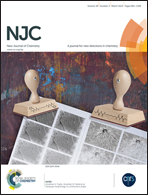Can a linear metal–metal bonded array of tetravanadium be stabilized between two dicyclopenta[a,e]pentalene ligands? A theoretical investigation†
Abstract
The 14-π cross-linked annulene dicyclopenta[a,e]pentalene (dcpp) is suggested for the first time to function as a sandwich ligand. According to density functional theory (DFT) calculations, upon being sandwiched between two dcpp ligands, the tetravanadium chain, without the support of auxiliary ligands, has two unpaired electrons and has a tendency for deformation to gain extra stability through multicenter bondings in the ground state. The one-electron ligand chlorine can lead to two types of structures, one with two chlorine atoms connecting to the two central vanadium atoms and the other one with two chlorine atoms connecting to the two terminal vanadium atoms, both of which are energetically more favorable in the triplet state. In the carbonyl end-capping complex, the tetravanadium is stable as a linear metal–metal bonded array with alternating single and double bonds and all electrons paired for bonding, although a triplet state conformer exists with two extra carbonyl ligands bound to the two central vanadium atoms which is more energy favorable by 15.1 kcal mol−1. Bonding features within the tetravanadium moiety were obtained based on electron density analyses. We hope these discussions are helpful for the design of new extended metal atom chain (EMAC) systems and for the pursuit of effective catalysts based on the dcpp sandwich complexes.
![Graphical abstract: Can a linear metal–metal bonded array of tetravanadium be stabilized between two dicyclopenta[a,e]pentalene ligands? A theoretical investigation](/en/Image/Get?imageInfo.ImageType=GA&imageInfo.ImageIdentifier.ManuscriptID=C3NJ00857F&imageInfo.ImageIdentifier.Year=2014)

 Please wait while we load your content...
Please wait while we load your content...